Advanced Metamaterial-Integrated Dipole Array Antenna for Enhanced Gain in 5G Millimeter-Wave Bands
Abstract
:1. Introduction
2. The Design of the Metamaterial-Integrated Dipole Antenna
2.1. The Dipole Array Antenna Design
2.2. Metamaterial Unit Cell Design
2.3. The Dipole Array Antenna with the Proposed Metamaterial Structure
3. Antenna Results and Discussion
3.1. Reflection Coefficient
3.2. Radiation Pattern
3.3. Gain and Radiation Efficiency
3.4. Performance Comparison
4. Limitations and Future Work Directions
5. Conclusions
Author Contributions
Funding
Institutional Review Board Statement
Informed Consent Statement
Data Availability Statement
Conflicts of Interest
References
- Agiwal, M.; Roy, A.; Saxena, N. Next Generation 5G Wireless Networks: A Comprehensive Survey. IEEE Commun. Surv. Tutor. 2016, 18, 1617–1655. [Google Scholar] [CrossRef]
- Yu, X.; Li, J.; Hu, J.; Yao, Y.; Li, J.; Yan, S. Low-Profile Dual-Polarized Antenna Integrated with Horn and Vivaldi Antenna in Millimeter-Wave Band. Appl. Sci. 2023, 13, 9627. [Google Scholar] [CrossRef]
- Zhang, Y.; Luo, Y.; Ji, R. Millimeter-Wave High-Gain Dual-Polarized Flat Luneburg Lens Antenna with Reflection Cancellation. Appl. Sci. 2023, 13, 6468. [Google Scholar] [CrossRef]
- Azari, A.; Skrivervik, A.; Aliakbarian, H.; Sadeghzadeh, R.A. A Super Wideband Dual-Polarized Vivaldi Antenna for 5G mmWave Applications. IEEE Access 2023, 11, 80761–80768. [Google Scholar] [CrossRef]
- Zhu, Y.; Chen, K.; Tang, S.Y.; Yu, C.; Hong, W. Ultrawideband Strip-Loaded Slotted Circular Patch Antenna Array for Millimeter-Wave Applications. IEEE Antennas Wireless Propag. Lett. 2023, 22, 2230–2234. [Google Scholar] [CrossRef]
- Hussain, N.; Kim, N. Integrated Microwave and mm-Wave MIMO Antenna Module with 360 Pattern Diversity for 5G Internet of Things. IEEE Internet Things J. 2022, 9, 24777–24789. [Google Scholar] [CrossRef]
- International Telecommunication Union (ITU). Spectrum Allocation for 5G International Framework. Available online: https://www.itu.int/en/ITU-D/Regional-Presence/Europe/Documents/Events/2019/RED-2019/presentation/4.5-%D0%A0%D0%B5%D1%81%D1%82%D1%80%D0%B5%D0%BF%D0%BE.pdf (accessed on 16 April 2024).
- Abdou, T.S.; Saad, R.; Khamas, S.K. A Circularly Polarized mmWave Dielectric-Resonator-Antenna Array for Off-Body Communications. Appl. Sci. 2023, 13, 2002. [Google Scholar] [CrossRef]
- Lo, J.J.; Chen, Z.N. Design of a Broadband Millimeter-Wave Array Antenna for 5G Applications. IEEE Antennas Wireless Propag. Lett. 2022, 22, 1030–1034. [Google Scholar]
- Sufian, M.A.; Hussain, N.; Choi, D.; Lee, S.M.; Gil, S.K.; Kim, N. High Gain Quasi-Omnidirectional Dipole Array Fed by Radial Power Divider for Millimeter-Wave IoT Sensing. Sci. Rep. 2024, 14, 16279. [Google Scholar] [CrossRef]
- Zhu, Y.; Deng, C. Wideband Dual-Polarized Endfire Phased Array Antenna with Small Ground Clearance for 5G mmWave Mobile Terminals. IEEE Trans. Antennas Propag. 2023, 71, 5469–5474. [Google Scholar] [CrossRef]
- International Telecommunication Union (ITU). ETSI & 3GPP 5G Standardization toward IMT-2020 Radio Spectrum and Interface. Available online: https://www.itu.int/en/ITU-D/Regional-Presence/Europe/Documents/Events/2018/5GHungary/S3%20Mihaljevic%205G%20Standard.pdf (accessed on 11 March 2024).
- Sheik, J.A. Intelligent Signal Processing and RF Energy Harvesting for State of Art 5G and B5G Networks; Springer Nature: Berlin, Germany, 2024; pp. 97–112. [Google Scholar]
- Oh, J.; Kim, B.; Yoon, S.; Kim, K.; Sung, E.J.; Oh, J. High-Gain Millimeter-Wave Antenna-in-Display Using Non-Optical Space for 5G Smartphones. IEEE Trans. Antennas Propag. 2022, 71, 1458–1468. [Google Scholar] [CrossRef]
- Sufian, M.A.; Hussain, N.; Kim, N. Quasi-Binomial Series-Fed Array for Performance Improvement of Millimeter-Wave Antenna for 5G MIMO Applications. Eng. Sci. Technol. Int. J. 2023, 47, 101548. [Google Scholar] [CrossRef]
- Wen, L.; Yu, Z.; Zhu, L.; Zhou, J. High-Gain Dual-Band Resonant Cavity Antenna for 5G Millimeter-Wave Communications. IEEE Antennas Wireless Propag. Lett. 2021, 20, 1878–1882. [Google Scholar] [CrossRef]
- Hwang, I.J.; Ahn, B.; Chae, S.C.; Yu, J.W.; Lee, W.W. Quasi-Yagi Antenna Array with Modified Folded Dipole Driver for mmWave 5G Cellular Devices. IEEE Antennas Wireless Propag. Lett. 2019, 18, 971–975. [Google Scholar] [CrossRef]
- Kimionis, J.; Georgiadis, A.; Daskalakis, S.N.; Tentzeris, M.M. A Printed Millimetre-Wave Modulator and Antenna Array for Backscatter Communications at Gigabit Data Rates. Nat. Electron. 2021, 4, 439–446. [Google Scholar] [CrossRef]
- Attia, H.; Abdelghani, M.L.; Denidni, T.A. Wideband and High-Gain Millimeter-Wave Antenna Based on FSS Fabry–Perot Cavity. IEEE Trans. Antennas Propag. 2017, 65, 5589–5594. [Google Scholar] [CrossRef]
- Zhai, G.; Cheng, Y.; Yin, Q.; Zhu, S.; Gao, J. Gain Enhancement of Printed Log-Periodic Dipole Array Antenna Using Director Cell. IEEE Trans. Antennas Propag. 2014, 62, 5915–5919. [Google Scholar] [CrossRef]
- Kim, J.; Lee, H.L. High Gain Planar Segmented Antenna for mmWave Phased Array Applications. IEEE Trans. Antennas Propag. 2022, 70, 5918–5922. [Google Scholar] [CrossRef]
- Nkimbeng, C.H.S.; Wang, H.; Byun, G.; Park, Y.B.; Park, I. Non-Uniform Metasurface-Integrated Circularly Polarized End-Fire Dipole Array Antenna. J. Electromagn. Eng. Sci. 2023, 23, 109–121. [Google Scholar] [CrossRef]
- Wu, Q.; Hirokawa, J.; Yin, J.; Yu, C.; Wang, H.; Hong, W. Millimeter-Wave Multibeam Endfire Dual-Circularly Polarized Antenna Array for 5G Wireless Applications. IEEE Trans. Antennas Propag. 2018, 66, 4930–4935. [Google Scholar] [CrossRef]
- Chen, H.; Shao, Y.; Zhang, Y.; Zhang, C.; Zhang, Z. A Low-Profile Broadband Circularly Polarized mmWave Antenna with Special-Shaped Ring Slot. IEEE Antennas Wireless Propag. Lett. 2019, 18, 1492–1496. [Google Scholar] [CrossRef]
- Munir, M.E.; Nasralla, M.M.; Esmail, M.A. Four Port Tri-Circular Ring MIMO Antenna with Wide-Band Characteristics for Future 5G and mmWave Applications. Heliyon 2024, 10, e28714. [Google Scholar] [CrossRef] [PubMed]
- Ozpinar, H.; Aksimsek, S.; Tokan, N.T. A Novel Compact, Broadband, High Gain Millimeter-Wave Antenna for 5G Beam Steering Applications. IEEE Trans. Veh. Technol. 2020, 69, 2389–2397. [Google Scholar] [CrossRef]
- Jeong, M.J.; Hussain, N.; Park, J.W.; Park, S.G.; Rhee, S.Y.; Kim, N. Millimeter-Wave Microstrip Patch Antenna Using Vertically Coupled Split Ring Metaplate for Gain Enhancement. Microw. Opt. Technol. Lett. 2019, 61, 2360–2365. [Google Scholar] [CrossRef]
- Esmail, B.A.; Koziel, S. Design and Optimization of Metamaterial-Based 5G Millimeter Wave Antenna for Gain Enhancement. IEEE Trans. Circuits Syst. II Express Briefs 2023, 70, 3348–3352. [Google Scholar] [CrossRef]
- Saleh, C.M.; Almajali, E.; Jarndal, A.; Yousaf, J.; Alja’Afreh, S.S.; Amaya, R.E. Wideband 5G Antenna Gain Enhancement Using a Compact Single-Layer Millimeter Wave Metamaterial Lens. IEEE Access 2023, 11, 14928–14942. [Google Scholar] [CrossRef]
- Chen, X.; Grzegorczyk, T.M.; Wu, B.I.; Pacheco, J., Jr.; Kong, J.A. Robust Method to Retrieve the Constitutive Effective Parameters of Metamaterials. Phys. Rev. E Stat. Nonlinear Soft Matter Phys. 2004, 70, 016608. [Google Scholar] [CrossRef]
- Chen, L.; Lei, Z.; Yang, R.; Fan, J.; Shi, X. A Broadband Artificial Material for Gain Enhancement of Antipodal Tapered Slot Antenna. IEEE Trans. Antennas Propag. 2014, 63, 395–400. [Google Scholar] [CrossRef]
- Esmail, B.A.; Koziel, S.; Pietrenko-Dabrowska, A.; Isleifson, D. Wideband High-Gain Low-Profile Series-Fed Antenna Integrated with Optimized Metamaterials for 5G Millimeter Wave Applications. Sci. Rep. 2024, 14, 185. [Google Scholar] [CrossRef]
- Khoutar, F.Z.; Nayat-Ali, O.; Aznabet, M.; El Mrabet, O. A Multifunctional Patch Antenna Loaded with Near Zero Index Refraction Metamaterial. Prog. Electromagn. Res. M 2022, 114, 127–137. [Google Scholar] [CrossRef]
- Smith, D.R.; Vier, D.C.; Koschny, T.; Soukoulis, C.M. Electromagnetic Parameter Retrieval from Inhomogeneous Metamaterials. Phys. Rev. E Stat. Nonlinear Soft Matter Phys. 2005, 71, 036617. [Google Scholar] [CrossRef] [PubMed]
- Li, D.; Szabó, Z.; Qing, X.; Li, E.P.; Chen, Z.N. A High Gain Antenna with an Optimized Metamaterial Inspired Superstrate. IEEE Trans. Antennas Propag. 2012, 60, 6018–6023. [Google Scholar] [CrossRef]
- Patel, S.K.; Shah, K.H.; Kosta, Y.P. Frequency-Reconfigurable and High-Gain Metamaterial Microstrip-Radiating Structure. Waves Random Complex Media 2019, 29, 523–539. [Google Scholar] [CrossRef]
- EMTI Homepage. Available online: http://emti.or.kr/ (accessed on 12 December 2021).
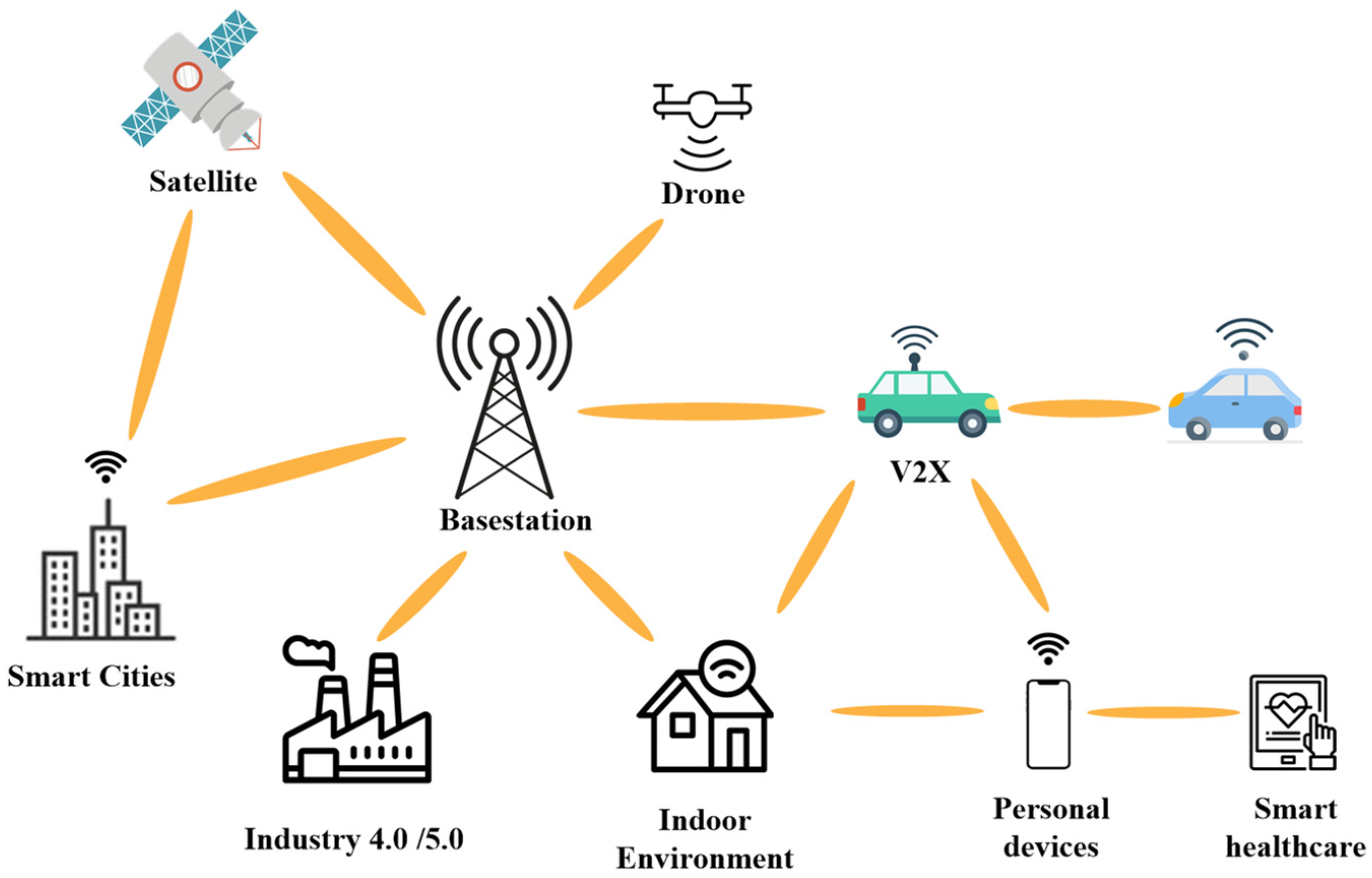

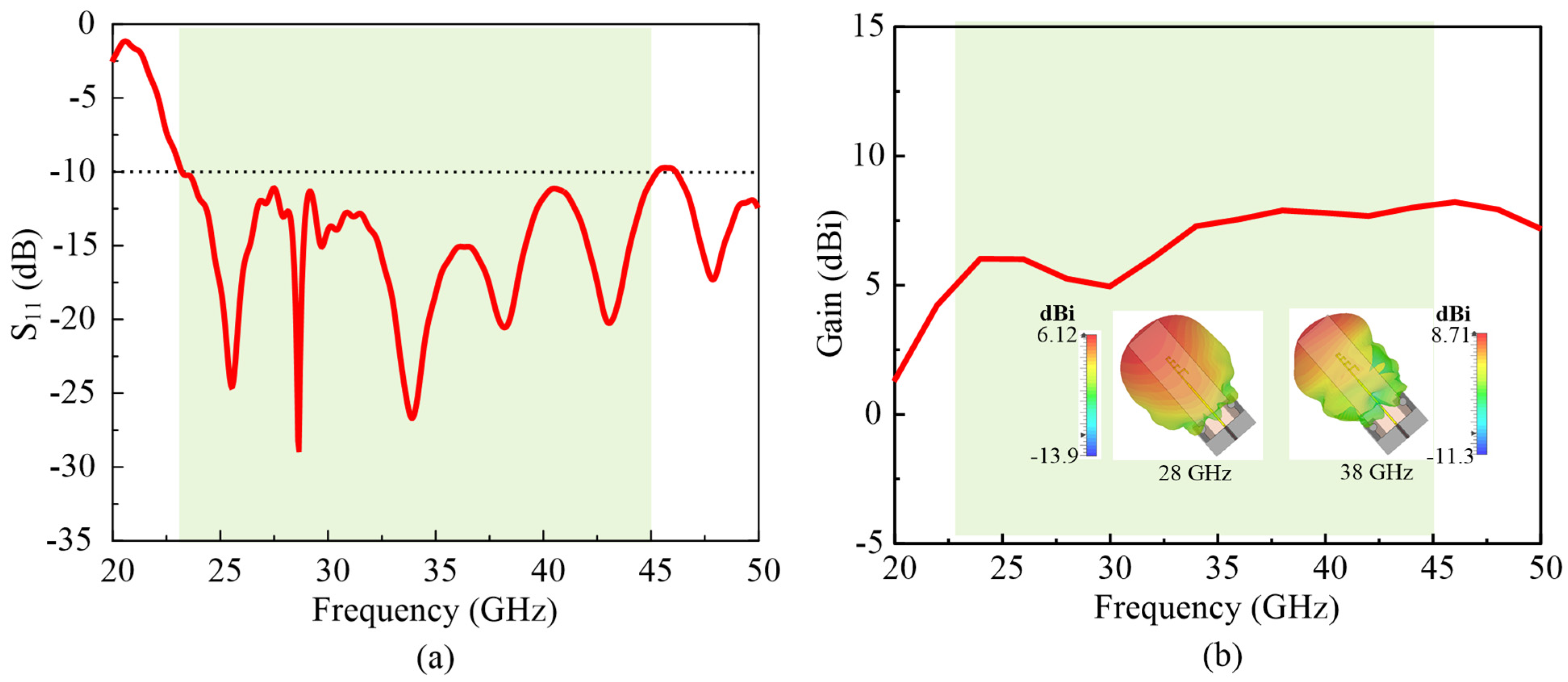
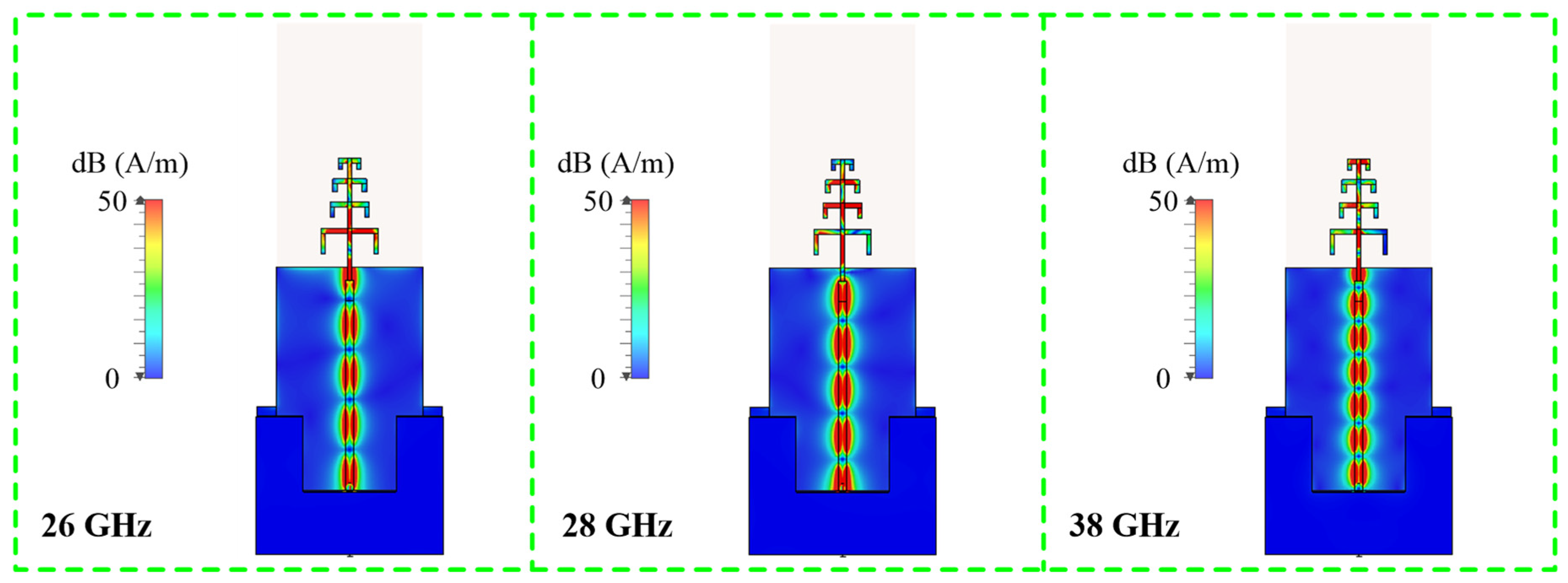
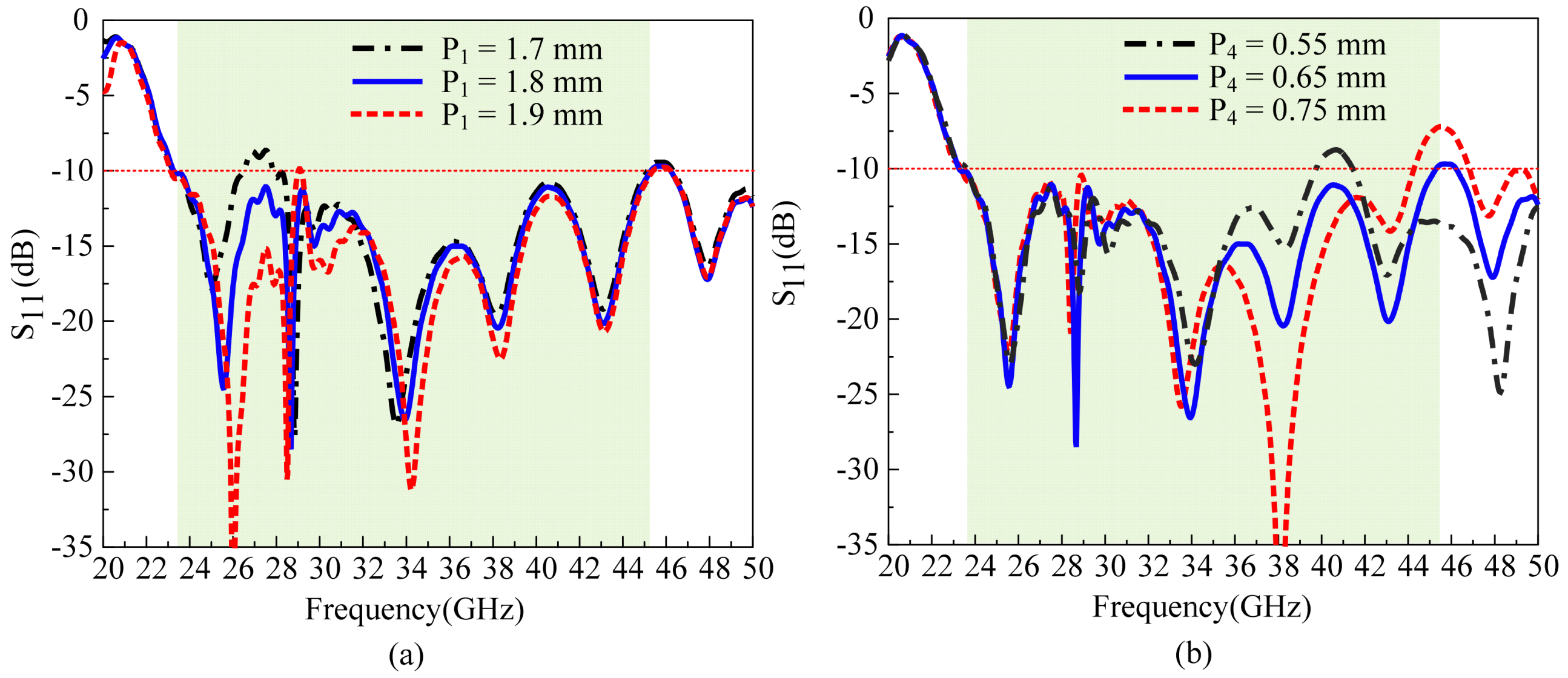

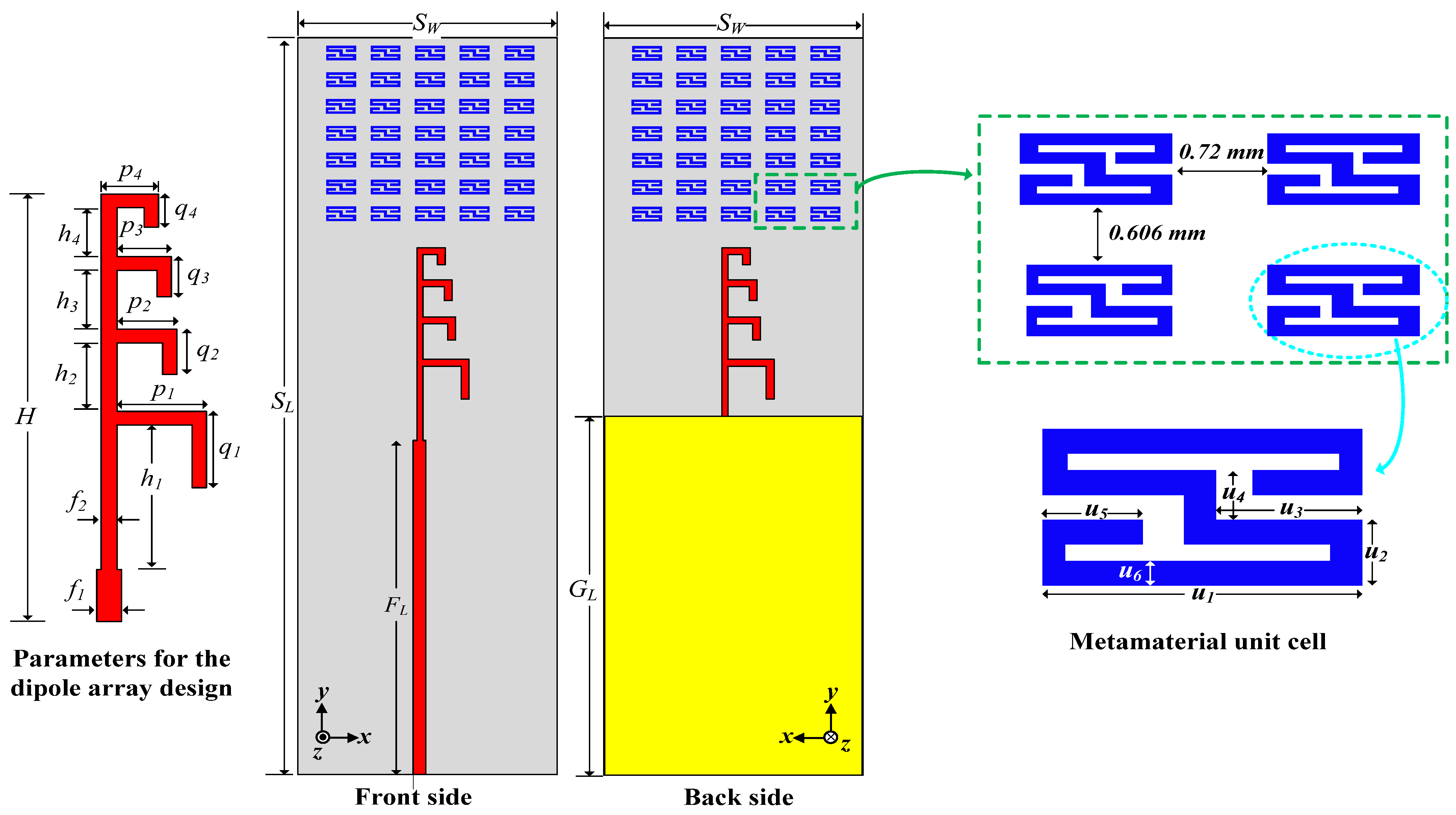
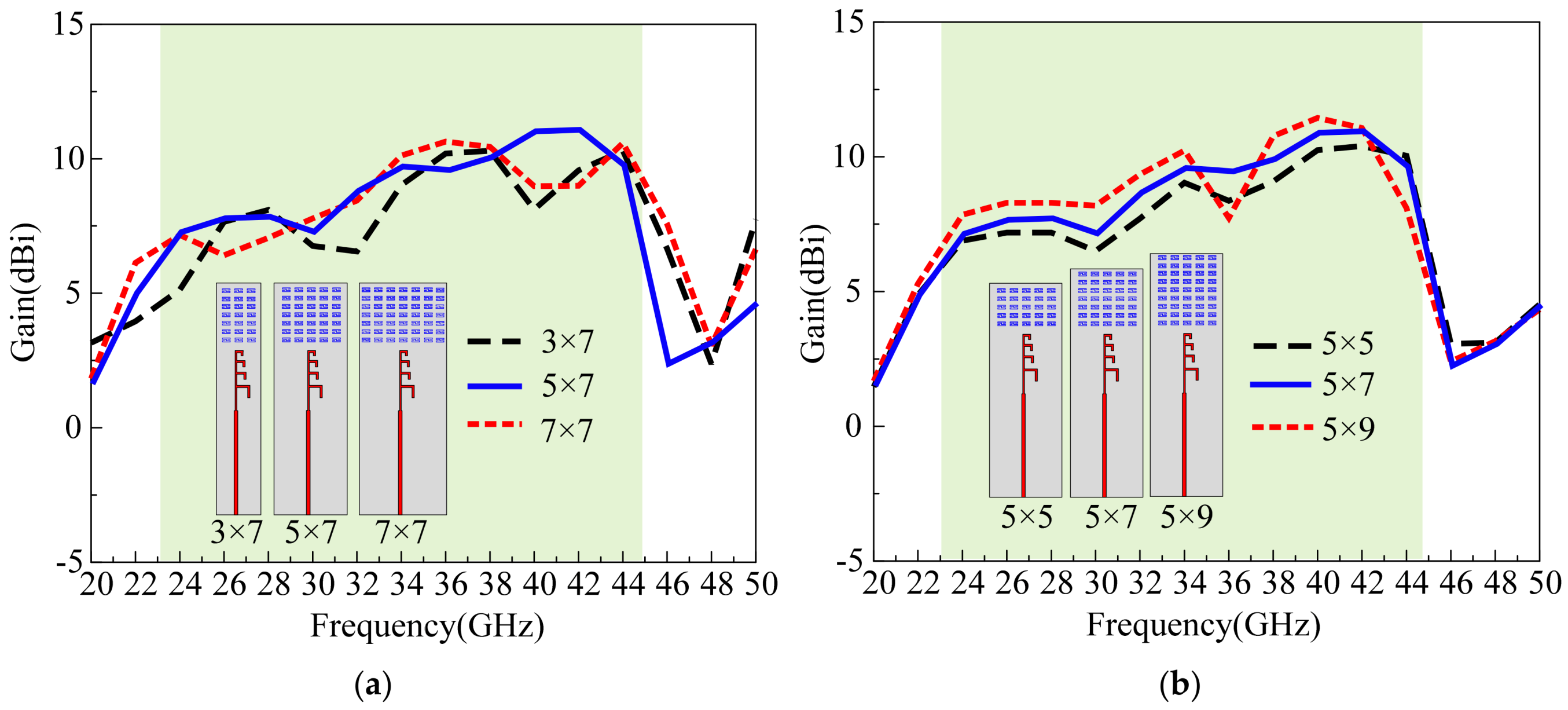
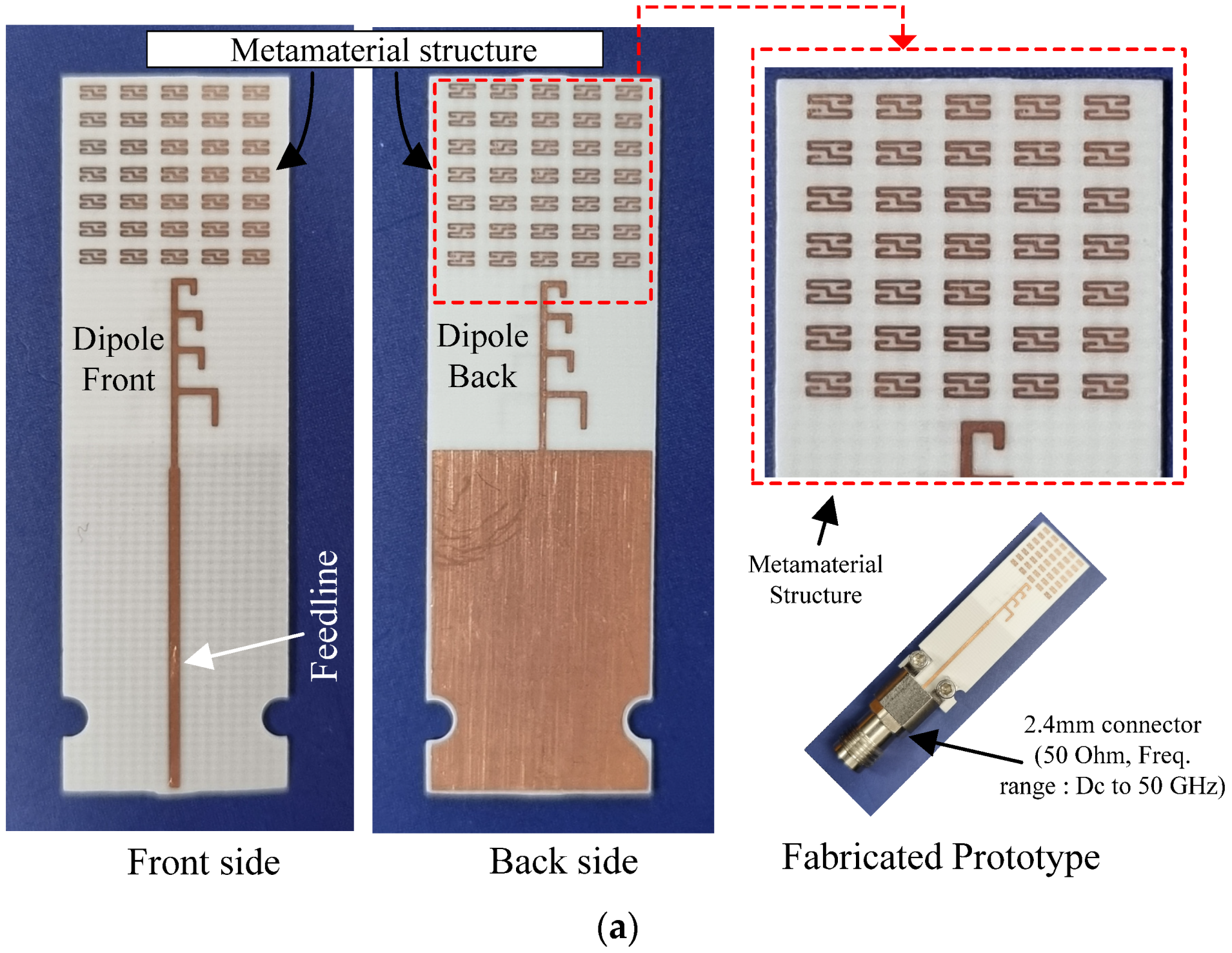

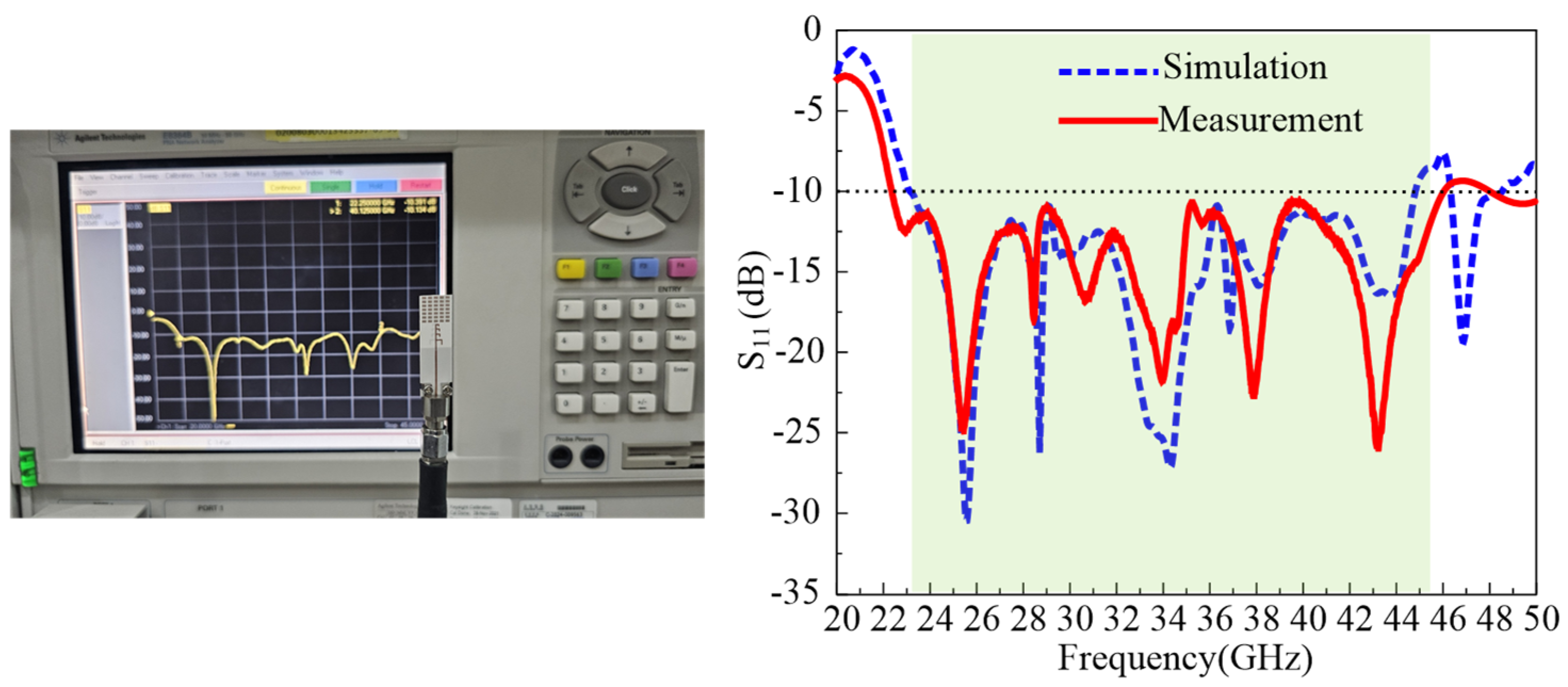


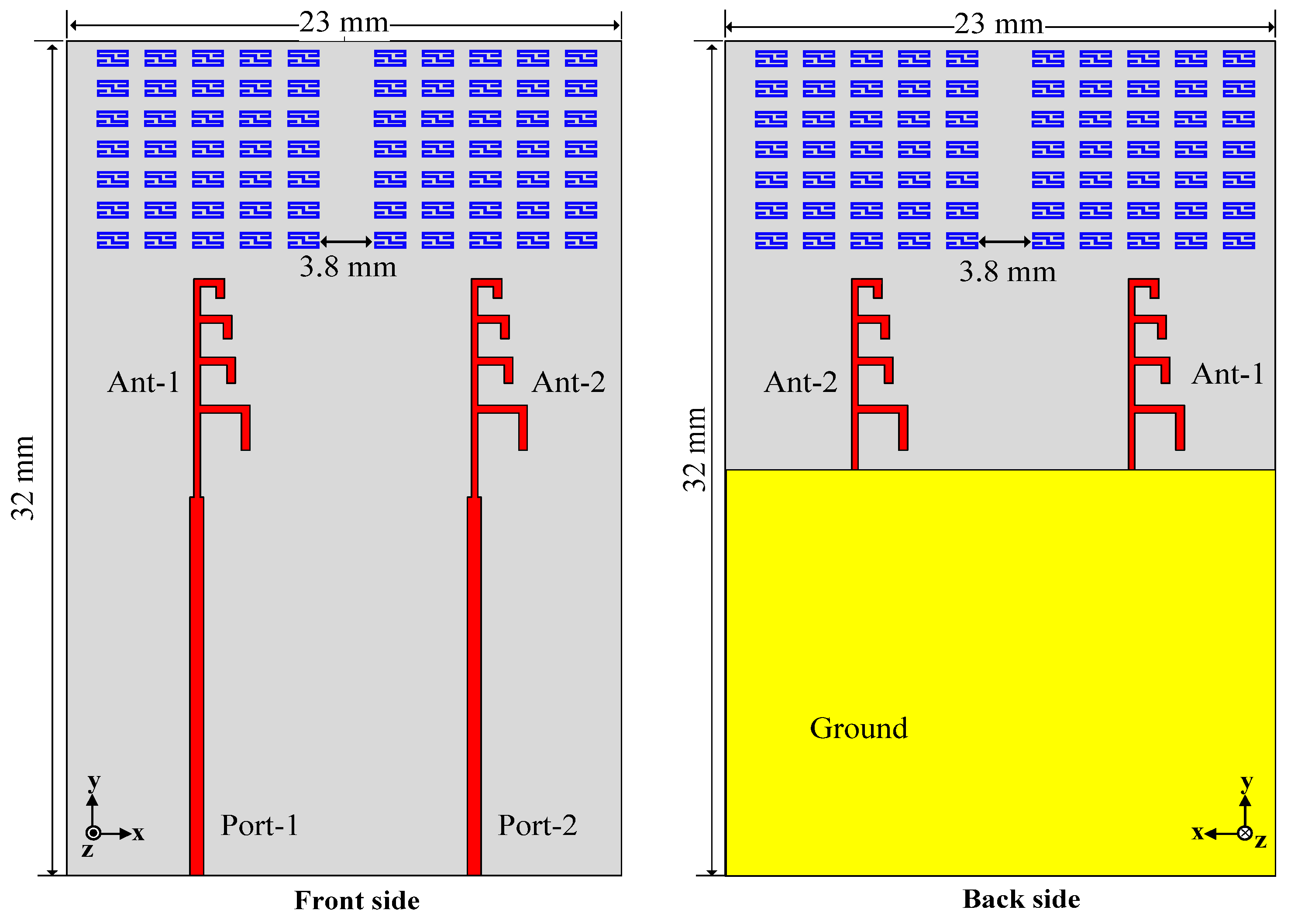
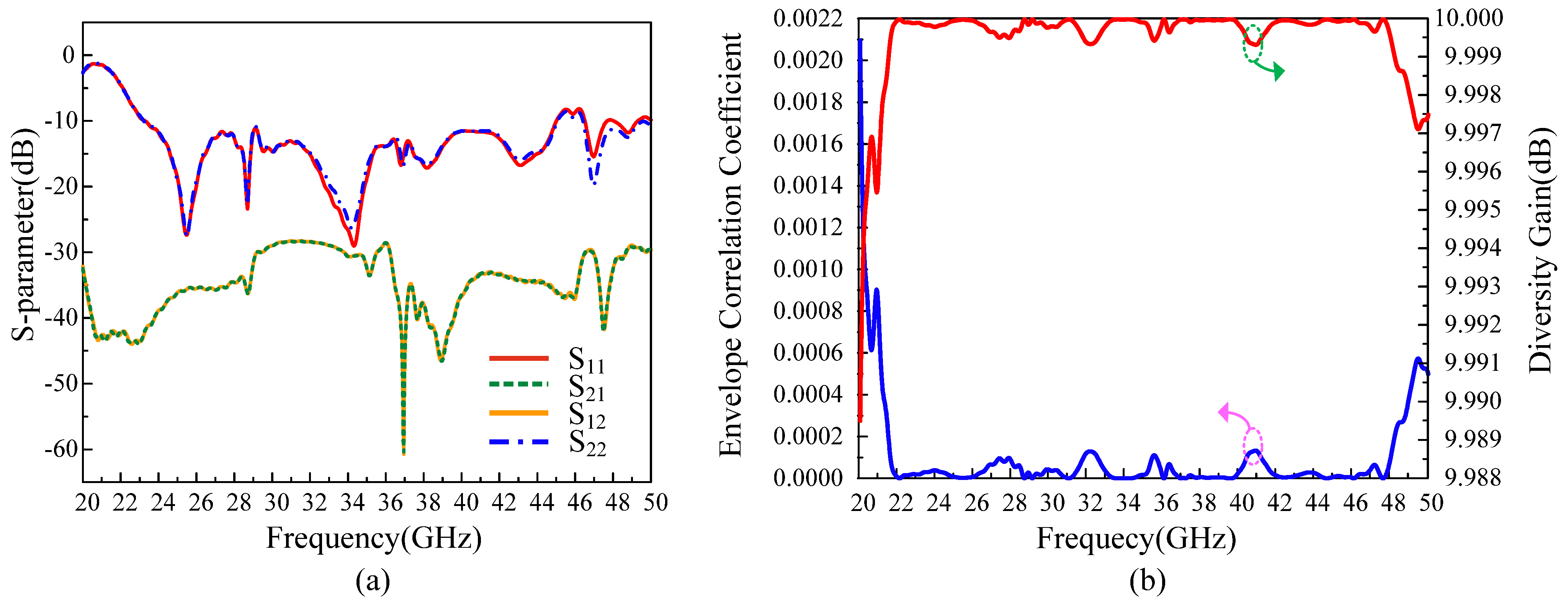
| Parameter | Value (mm) | Parameter | Value (mm) | Parameter | Value (mm) | Parameter | Value (mm) |
|---|---|---|---|---|---|---|---|
| SL | 32 | f2 | 0.3 | h3 | 1.3 | p4 | 0.65 |
| Sw | 10 | L | 3.2 | h4 | 1.1 | q1 | 1.4 |
| FL | 14.4 | H | 8.3 | p1 | 1.8 | q2 | 0.7 |
| GL | 15.3 | h1 | 3.2 | p2 | 1.17 | q3 | 0.6 |
| f1 | 0.5 | h2 | 1.5 | p3 | 1 | q4 | 0.45 |
| Parameter | Value (mm) | Parameter | Value (mm) | Parameter | Value (mm) |
|---|---|---|---|---|---|
| u1 | 1.08 | u3 | 0.495 | u5 | 0.27 |
| u2 | 0.252 | u4 | 0.18 | u6 | 0.09 |
| Metamaterial Arrangement | Gain (dBi) | Frequency Response (GHz) | Metamaterial Arrangement | Gain (dBi) | Frequency Response (GHz) | ||
|---|---|---|---|---|---|---|---|
| Min. | Max. | Min. | Max. | ||||
| 3 × 7 | 5.12 | 10.3 | 23.5–40.1 | 5 × 5 | 6.5 | 10.39 | 23.3–40.9 |
| 5 × 7 | 7.28 | 11.21 | 23.1–44.8 | 5 × 7 | 7.28 | 11.21 | 23.1–44.8 |
| 7 × 7 | 6.4 | 10.63 | 23.5–40.6 | 5 × 9 | 7.72 | 11.43 | 23.2–36.4 36.5–39.6 40.7–44.8 |
| Freq. (GHz) | HPBW (°) | Freq. (GHz) | HPBW (°) | Freq. (GHz) | HPBW (°) | Freq. (GHz) | HPBW (°) | ||||
|---|---|---|---|---|---|---|---|---|---|---|---|
| E Plane | H Plane | E Plane | H Plane | E Plane | H Plane | E Plane | H Plane | ||||
| 22 | 73 | 87.2 | 28 | 54.1 | 74.4 | 34 | 42.4 | 47.6 | 40 | 31.6 | 45 |
| 24 | 54.6 | 75.9 | 30 | 60.3 | 72.8 | 36 | 38.3 | 45.2 | 42 | 28.1 | 42.9 |
| 26 | 51.7 | 76.8 | 32 | 50.7 | 59.1 | 38 | 35.2 | 50.2 | 44 | 24.9 | 43.7 |
| Refs. | Antenna Type | Total Antenna Size (λ × λ × λ) | Center Freq. (GHz) | BW (%) | Radiation Direction | Peak Gain (dBi) | Substrate Layers |
|---|---|---|---|---|---|---|---|
| [17] | Quasi-Yagi | 5.88 × 4.22 × 0.07 | 28 | 9.64 | Broadside | 9.8 | Single |
| [18] | Planar series-array antenna | 6.07 × 1.74 × 0.015 | 26 | 15.38 | Broadside | 10 | Single |
| [20] | Log-periodic dipole array + director cell | 2.49 × 1.51 × 0.05 | 30.5 | 58.46 | End-fire | 10.95 | Single |
| [21] | Multi-layer planar segmented antenna (PSA) | 1.213 × 1.213 × 0.113 | 28 | 21.6 | Broadside | 11.5 | Double |
| [22] | Metasurface-integrated dipole | 2.76 × 2.76 × 2.78 | 30.5 | 21.5 | End-fire | 11 | Single + 2 layers of metasurface |
| [23] | Dielectric-loaded stepped slot antenna + substrate-integrated waveguide (SIW) | 1.31 × 0.75 × 0.39 | 37.5 | 23.6 | End-fire | 7.2 | Double |
| [24] | Planar antenna with defective ground + metallic vias | 2.8 × 1.4 × 0.03 | 28 | 29.82 | Omnidirectional | 6.49 | Single |
| [25] | Ring-shaped patch with slotted ground | 0.77 × 1.21 × 0.028 | 33 | 42.4 | Omnidirectional | 5.36 | Single |
| [26] | Clover antenna array | 3.6 × 0.347 × 0.05 | 26 | 32.6 | Broadside | 9 | Single |
| [27] | Printed antenna + Metamaterial Layer | 1.68 × 2.05 × 1.65 | 27.96 | 5.9 | Broadside | 11.94 | Double + 1 foam layer |
| This work | Non-uniform dipole array with metamaterial | 2.98 × 0.93 × 0.019 | 33.95 | 63.92 | End-fire | 11.21 | Single |
Disclaimer/Publisher’s Note: The statements, opinions and data contained in all publications are solely those of the individual author(s) and contributor(s) and not of MDPI and/or the editor(s). MDPI and/or the editor(s) disclaim responsibility for any injury to people or property resulting from any ideas, methods, instructions or products referred to in the content. |
© 2024 by the authors. Licensee MDPI, Basel, Switzerland. This article is an open access article distributed under the terms and conditions of the Creative Commons Attribution (CC BY) license (https://creativecommons.org/licenses/by/4.0/).
Share and Cite
Choi, D.; Sufian, M.A.; Lee, J.; Awan, W.A.; Choi, Y.; Kim, N. Advanced Metamaterial-Integrated Dipole Array Antenna for Enhanced Gain in 5G Millimeter-Wave Bands. Appl. Sci. 2024, 14, 9138. https://doi.org/10.3390/app14199138
Choi D, Sufian MA, Lee J, Awan WA, Choi Y, Kim N. Advanced Metamaterial-Integrated Dipole Array Antenna for Enhanced Gain in 5G Millimeter-Wave Bands. Applied Sciences. 2024; 14(19):9138. https://doi.org/10.3390/app14199138
Chicago/Turabian StyleChoi, Domin, Md Abu Sufian, Jaemin Lee, Wahaj Abbas Awan, Young Choi, and Nam Kim. 2024. "Advanced Metamaterial-Integrated Dipole Array Antenna for Enhanced Gain in 5G Millimeter-Wave Bands" Applied Sciences 14, no. 19: 9138. https://doi.org/10.3390/app14199138









